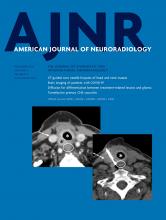Article Figures & Data
Tables
Characteristics No. of Patients 154 Age (mean) (SD) (yr) 67.6 (15.1) Range 21–94 Sex (No.) (%) Female 74 (48.1) Male 80 (51.9) Site of large-vessel occlusion (No.) (%) M1 65 (42.2) SC-ICA 29 (18.8) M2 28 (18.2) Tandem cervical ICA and M1 19 (12.3) Basilar artery 7 (4.5) P1 4 (2.6) Cervical ICA 2 (1.3) Laterality (No.) (%)a Right 63 (42.9) Left 84 (57.1) Arch configuration (No.) (%)b I 84 (62.7) II 35 (26.1) III 15 (11.2) Bovine anatomy (No.) (%)b No 110 (82.1) Yes 24 (17.9) Characteristics Access mode (No.) (%) Primary insertion 148 (96.1) Sheath 6 (3.9) Fubuki delivered to ICA? (No.) (%) Yes 151 (98.1) No 3 (1.9) Lesion crossed with Fubuki as guide? (No.) (%) Yes 150 (97.4) No 4 (2.6) Herniation of Fubuki into aortic arch? (No.) (%) Yes 1 (0.6) No 153 (99.4) Crossover to another guide catheter? (No.) (%) Yes 1 (0.6) No 153 (99.4) Mechanism of embolectomy (No.) (%) Aspiration 111 (72.1) Stent retriever 4 (2.6) Combined aspiration and stent retriever 34 (22.1) Failure 5 (3.2) ≥TICI 2b revascularization? (No.) (%) Yes 128 (83.1) No 26 (16.9) Time to lesion crossed (median) (min) 9 Range 4–102 Time to revascularization (median) (min) 17 Range 3–96 Major access site complications? (No.) (%) Yes 3 (1.9) No 151 (98.1) - Table 3:
Logistic regression identifying predictors of failure to deliver the Fubuki to the ICA
Variable OR (95% CI) P Value Age (yr) 2.04 (0.66–6.36)a .22 Male sex 0.46 (0.04–5.13) .52 Left-sided occlusion 0.36 (0.03–4.15) .42 Bovine anatomy 2.35 (0.20–27.00) .49 Bovine and left-sided occlusion 4.54 (0.38–53.54) .23 Type III aortic arch 18.15 (1.54–214.16) .021b












